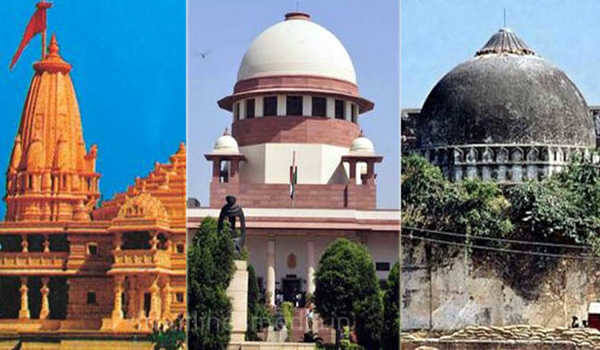Ayodhya Dateline: Events That Lead Up to Ram Mandir Bhumi Pujan
One of the longest-running battles in India’s legal history. The first case in the Ayodhya title dispute was filed 134 years ago.
Here are the events that led up to the construction of Ram Mandir in once disputed site:
1. The first recorded legal history in Ayodhya dispute dates back to 1858. An FIR was filed on November 30, 1858, by one Mohd Salim against a group of Nihang Sikhs who had installed their nishan and written “Ram” inside the Babri mosque.
2. The legal fight began in 1885 when Mahanth Raghubar Das filed a suit (No. 61/280) against Secretary of State for India in Council in the civil court of Faizabad. In his suit, Das claimed that he was a mahanth and was located at the chabutra in the outer courtyard and should be permitted to construct a temple there.
3. For the next 63 years, there was no legal progress in the case. In 1934, a riot took place in Ayodhya and Hindus demolished a portion of the structure of the disputed site. The portion was rebuilt by the Britishers.
4. In the intervening night of 22 and 23rd December of 1949, idols were found inside the central dome of the mosque.
5. On January 16, 1950, Gopal Singh Visharad of the Hindu Maha Sabha became the first person to file a suit in independent India in the case.
6. On May 25, the second suit was filed by Pramahans Ramchandra Das against Zahoor Ahmad and others and it was similar to that of the first suit.
7. Nine years later, on December 17, 1959, Nirmohi Akhada filed the third suit to take over the management from the receiver.
8. Two years later, on December 18, 1961, Sunni Central Waqf Board along with all those defendants named in the earlier suits, filed the fourth suit in the court of civil judge, Faizabad, praying for the removal of idols and handing over the possession of mosque.
9. On March 20, 1963, the court held that the entire Hindu community can’t be represented by a few persons. It ordered a public notice to implead Hindu Maha Sabha, Arya Samaj, and Sanatan Dharma Sabha as defendants to represent the Hindu community.
10. On January 25, 1986, Umesh Chandra Pandey, an advocate, filed an application with Munsif Magistrate, Faizabad, praying that the locks should be opened and people should be allowed to have darshan of the idols that had been found inside.
11. After the locks were opened, the Muslim leaders met in Lucknow on February 6, and a Babri Masjid Action Committee was formed with Zafaryab Jilani as the convenor.
12. On July 1, 1989, a fifth suit was filed by former Allahabad High Court Judge Deoki Nandan Agarwal as “next friend” of Ram Lala Virajman before the civil judge in Faizabad.
13. In 1989, the Shia Waqf Board also filed a suit and became a defendant in the case.
14. On July 12, 1989, the Allahabad High Court passed an order transferring all the suits to a three-judge bench of the high court.
15. On October 7 and 10, 1991, the BJP state government acquired premises in dispute along with some adjoining area (total 2.77 acres of land) to develop it for tourism purposes under the land acquisition Act.
16. On December 6, 1992, the mosque was demolished despite interim orders passed by the Supreme Court and the high court, and 49 FIRs were registered against several people, including BJP leaders, in the demolition case.
17. On December 21, 1992, Hari Shankar Jain filed a petition in the Lucknow bench of the Allahabad High Court that it was his fundamental right to worship Lord Ram.
18. On January 1, 1993, the high court held that every Hindu has the right to worship at the place believed to be the birthplace of Lord Ram.
19. Thirteen years after the Allahabad High Court took the case in March 2002, the hearing began for the title suit of the Ayodhya dispute.
20. In July 2003, the Allahabad High Court ordered excavation at the disputed site.
21. The Archaeological Survey of India (ASI) did the excavation and submitted its report on August 22, 2003. In its report, ASI said that there was a massive structure beneath the disputed structure and there were artifacts of Hindu pilgrimage.
22. On September 30, 2010, the three-judge bench of Justice Dharamveer Sharma, Justice Sudhir Agarwal and Justice SU Khan of the Allahabad High Court gave its judgment in the title suit. It divided the disputed land into three parts, giving one each to Ram Lala, Nirmohi Akhada, and Sunni Waqf Board.
23. In February last year, Chief Justice of India Ranjan Gogoi formed a five-judge bench under him, along with Justice Ashok Bhushan, Justice Nazeer, Justice Bobde and Justice Chandrachud.
24. The bench proposed a court-monitored mediation Former SC Judge Justice FM Kalifulla, Sri Sri Ravi Shankar, and senior advocate Sriram Panchu were in the mediation panel.
25. Seven rounds of discussion took place but it didn’t yield results. On August 2, the court decided to start a regular hearing from August 6.
26. The arguments from all the sides in the case were completed on October 16 and the judgment was reserved.
27. On November 9, 2019, the Supreme Court bench rules unanimously that a Ram temple be constructed at the disputed site and the Centre allot a five-acre plot elsewhere for a mosque.
28. On August 5, 2020, Ram Janmabhoomi Teerth Kshetra Trust will be holding Bhumi Pujan for the construction of Ram Mandir in Ayodhya.









